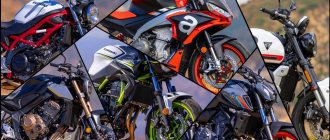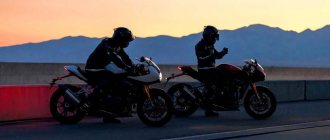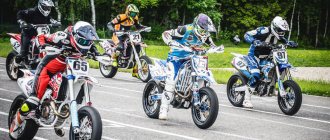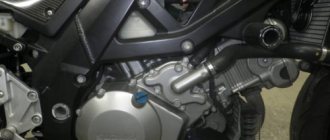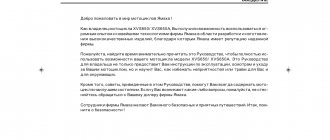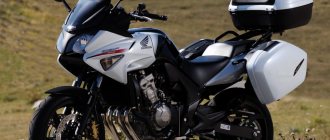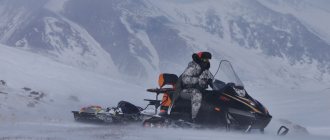Main advantages
Of course, Kawasaki took into account the unpleasant moments that were in the previous model, and now the engine has a longer service life, and everything is much better with the chain. The Kawasaki ZZR 1200 can easily be called “working on mistakes.”
Among the advantages of the motorcycle:
- comfortable, relatively upright seating position;
- developed wind protection system;
- aluminum frame.
Some would consider it a plus that the bike has a carburetor fuel supply system. This sports touring motorcycle is perfect for aesthetes with a penchant for tourism and just long trips.
Engine
The engine is an in-line, four-stroke, four-cylinder unit. Its compression ratio reaches 10.6:1, and its working volume is 1164 cm³. The maximum characteristics are as follows: at 8200 rpm, the torque is 124 Nm; at 9500 rpm the power reaches 160 hp.
The speed characteristics are even more impressive than those of the 1100 model: in just 2.8 seconds the motorcycle accelerates to 100 km/h, and its top speed is 294 km/h. This makes the ZZR 1200 a good choice for those who like to drive fast on race tracks.
text from Motorreview No. 2, 2002:
Alexander Dmitriev
Kawasaki ZZ-R1200: 1164 cm3, 152 hp, 290 km/h, $14,300.
Gravitating towards sports tourists, not everyone decides to go on a long voyage. But there are more than enough people who like to ride around the area. The secret to the popularity of these expensive motorcycles is a rare combination of power and comfort.
Without aggression What can I say – I’m like that myself. Classic sportbikes don’t attract me too much - they provoke you to go faster than you can. And “sports” with a tourist bias are what you need. Endowed with a good reserve under the right handle, they are not very agile in turns, but they inspire confidence on the straights. And they delight with what is called “high class” - huge dashboards, wide saddles, and careful wind protection. Of course, riding such motorcycles around the city is not using them for their intended purpose. But if you stick to dogma, it’s better not to get out of the car at all! The Kawasaki ZZ-R1200 replaces the ZZ-R1100, which was produced for more than 10 years. The predecessor is familiar far and wide; it is one of the bestsellers in the category of large sport bikes. Let's not forget a well-known historical fact: until 1996, the old ZZ-R confidently held the highest bar among powerful and high-speed motorcycles. This means that the ZZ-R1200 should please you with something unusual.
However, there is no need to expect sensations: Kawasaki representatives do not hide the fact that all extraordinary solutions are used in the ZX-12R, because today it is the most powerful production bike in the world. What the ZZ-R1200 completely lacks is aggression. Biodesign, popular several years ago, has received a new interpretation in an eye-catching solidity. In contrast to the sharp headlights and angry air intakes of the Ninja series bikes, the ZZ-R looks peaceful and friendly. You can’t say about someone like this: “he wants to give way.” However, does a bike with more than one and a half hundred “horses” hidden under the plastic need to give up something?
Driving in the wet The wind drove clouds across the sky all day, and by evening it started pouring like buckets. A wet road is not the best companion for a powerful and completely new motorcycle, but I didn’t wait for the weather to improve. At the same time I got the opportunity to practice driving slowly. I didn’t like plodding along in the traffic at all: as soon as the speed exceeds 40 km/h, I want to open the gas fully. But you can’t - the slippery asphalt will not forgive pranks. I make my way through a traffic jam - it has become more convenient to do this than on the ZZ-R1100, although not much more. Driving between cars is made difficult by widely spaced mufflers, but there is no escape from them. Contrary to my fears, I got used to the motorcycle faster than I had planned, and after only 30 km of city riding I began to allow myself to accelerate on wet roads. And I noticed the first feature of the new model. The engine responds to the gas with a slight delay and does so smoothly, without malice. Obviously, this is done to make it easier to control the powerful motorcycle. In any case, on a wet road, the slippage of the rear wheel is clearly controlled. This is especially valuable when turning: the engine reacts quite inertly when releasing the gas, allowing the pilot not to think about the rear brake. The manufacturer does not offer ABS - but the existing brakes are designed with the expectation that they will not be used by a racer. Soft levers allow you to accurately dose the forces even on a wet road, which ensures control over skidding of the wheels. The excellent straight-line stability of the motorcycle helps - even when locked, the front end does not instantly drift to the side.
And when, if not in the rain, will you appreciate the quality of the fairing! I didn’t get my leather overalls and boots wet even after two hours of riding without a raincoat.
To the dacha! To a cottage, a villa, out of town - wherever you want, the meaning of the event will not change. It’s no secret that when we talk about traveling on the highway, we often mean dynamic driving from the center of a metropolis about 50 kilometers from the city. Well, 100 is the ceiling. With these thoughts, I rode my new bike outside the Moscow Ring Road. The usual Simferopol highway was met with not too intense traffic. Left lane – 220 km/h. Stability is excellent, wind protection is also excellent. The aerodynamics of the bike are excellent. But the fit of the cladding parts suffers - in some modes the plastic begins to vibrate unpleasantly. However, you can put up with this. Kilometers fly by faster than fast: high-speed maneuvering in traffic is very confident, you don’t get the feeling that you can’t change the trajectory at will. I remembered the ZZ-R1100 - such a feeling arose on it.
On the way back, I took a passenger on board, so I pre-tensioned the spring of the rear shock absorber, fortunately this is very easy to do - using a remote hydraulic drive. Putting more load on your motorcycle is a good way to test your suspension and make sure it's reliable. During normal driving on a variety of roads, comfort is within normal limits, the shock absorbers do not break through, and there is no swaying observed. As for sportiness, of course, if you try to maneuver the ZZ-R into the steep turns of a race track, the rigidity of the hydraulics will clearly not be enough, but for such exercises there are other motorcycles!
With such thoughts, I forgot that I was not traveling alone. The passenger felt a little uneasy at the high speeds that the ZZ-R allowed him to develop without straining at all. Another conclusion was obvious: the ZZ-R is excellent for dynamic driving for two.
How about faster? I returned to the city a different person: firstly, the rain had stopped - the asphalt had dried, and, secondly, I was used to Kawasaki! Yes, this device requires some getting used to - it is powerful and relatively large-sized, it does not allow you to immediately turn off the full throttle. Thanks to the rain - it helped test the car in conditions of low wheel grip on asphalt. And with a habit - what can you do! The device is modern, it allows a lot, but it doesn’t like driving slowly. In dense traffic jams it is slightly clumsy, and at low speed it is inconvenient due to the overly sporty steering handles. I only noticed this on the second day! Otherwise, no complaints - there would be room to accelerate.
I didn’t want to emphasize it, I thought it would work out, but I have to mention it. The gears on the new Kawasaki shift unclearly, errors occur when shifting, and it is difficult to catch the neutral position. This is all the more offensive, because the motorcycle is equipped with a traditional Kawasaki gadget - a “neutral” search mechanism: when the bike is stationary, you can only turn it on to first gear, and from first to “neutral”. On the ZZ-R1200 all this works very poorly. But before, I considered Kawasaki gearboxes close to the standard... One can only hope that this is a feature of a single instance.
Smile more often Comparing the ZZ-R1200 with its classmates, which have appeared in abundance lately, one cannot help but want to highlight it in a separate line. Of course, it is powerful, controllable and comfortable. But it was special because of its appearance: wherever I drove it, I was met only with smiles. And no wonder. Look around - everything is completely black and scary. The angrier the better. The city is the jungle, the law is the taiga. The blue motorcycle of the highest class - not a scooter - seems to challenge the hidden aggression coming from literally everywhere. You ride it and rejoice - this Kawasaki is not capable of causing negative emotions.
Summary Kawasaki's new sport tourer with a powerful engine provides high levels of comfort and confident handling. The motorcycle is pleasant for the driver, but takes some getting used to. Convenient for riding with a passenger. The engine runs smoothly, which helps eliminate gross piloting errors. The imperfect fit of the cladding parts and the unclear operation of the gearbox are disappointing.
Options _
Debut/Start of Production 2001/2002 Dry weight 236 kg Curb weight 270 kg Dimensions 2175 mm Base 1505 mm Seat height 800 mm Ground clearance 115 mm Front fork pitch/reach 25о/105 mm Engine 1164 cm3, 4-stroke, in-line, 4 cylinders, DOHC, 16 valves, liquid cooling Dimension 79x59.4 mm Supply system 4 x Keihin CVKD40 Power 152 hp at rpm Torque Nm at rpm Transmission 6-speed gearbox, multi-plate wet clutch, chain Frame diagonal, aluminum alloy Front suspension telescopic fork O43 mm, travel 120 mm Rear suspension pendulum, monoshock absorber, progressive characteristics, adjustments - spring preload, stroke 120 mm Front brake 2 discs O320 mm, 4-piston calipers Rear brake disc O250 mm, 2-piston caliper Front wheel 120/70-ZR17 Rear wheel 180/55-ZR17 Gas tank volume 23 l Maximum speed km/h 294 km/h Acceleration 0-100 km/h 2.8 s Fuel consumption l/100 km 7.3 l/100 km
Dimensions and weight
The weight without fuel of the ZZR 1200 is 236 kg. This is not much considering the power that the car contains. For 100 km of road, the motorcycle will consume 7.3 liters of fuel, but this is not so significant, given that the gas tank capacity is 23 liters. The rear tire dimensions reach 180/55 ZR17, and the front tire dimensions reach 120/70 ZR17.
Chassis and brakes
The motorcycle is equipped with an aluminum tubular frame. In design it is very similar to that of the 1100. The wheels are, of course, alloy, just plain in shape. The steering wheel is approximately the same in size as its predecessor. It gives good controllability of the motorcycle at high speed.
The rear suspension is a progressive monoshock absorber with a stroke of 112 mm. Both rebound and preload can be adjusted. At the front, only the preload is adjustable, and the suspension is a telescopic fork with dimensions of 43 mm, with a stroke of 120 mm. The rear brake is a 250 mm disc with a single-piston caliper. The front brakes are provided by two discs, each 320 mm, assisted by four-piston calipers.
Test Drive Kawasaki ZZR 1200
No sooner said than done - we exchanged contacts, and a week later I was going to Kemerovo to visit my parents, and to the motsa show at the same time. The device is truly beautiful, however, I immediately decided to change the shade (airbrush it in winter), everything is new, the plastic mmm.. aahh.. it still smells like a factory. Still a 5 year old device.
